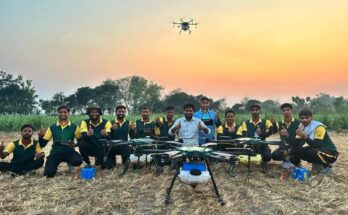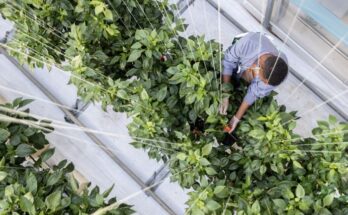NEW DELHI: FICCI-CropLife Technical Paper on ‘Drone Usage For Agrochemical Spraying’, released today highlights the application of agrochemical spraying via drones in India, the benefits and potential risk and mitigation strategy around it.
The report was released at a FICCI webinar ‘Drones Application Technology in Spraying for Crop Protection today.’
The technical paper also outlines the drone regulation in other countries such as the EU, Japan, Australia and New Zealand, citing the best practices in agrochemical spraying.
Speaking on the occasion, Amber Dubey, Joint Secretary, Ministry of Civil Aviation, Govt of India said that FICCI along with other industry stakeholders should come forward with indigenous solutions for Indian problems. Highlighting the potential of drones’ usage in the agriculture sector, he said, “There are around one lakh villages which can be benefited by the drones. We can design special purpose drones and industry must focus on developing low cost drones for them.”
He also stressed on industry tie-up with central or state level agricultural universities or institutions for getting the necessary approvals.
Addressing the webinar, Shomita Biswas, Joint Secretary (M&T), Ministry of Agriculture & Farmers Welfare said that drone enabled technology could be very useful in soil analysis of the fields. This could also help us in better irrigation management and maintaining correct nitrogen levels. She urged the start-ups to create drone planting system which will reduce the planting cost considerably.
Dr SK Malhotra, Agriculture Commissioner and Chairman, Registration Committee, Ministry of Agriculture & Farmers Welfare opined, “Drone spraying would help the farmers to increase their productivity, lower water consumption, higher efficiency; besides being safe for human and the environment. The Registration Committee is looking into various aspects of product approvals through drones application.”
Shedding light on the industry size, Rajan Luthra, Chairman, FICCI Committee on Drones said, “Start-ups, industry, government agencies and academia are collaborating actively as a cohesive drone ecosystem.” India has over 150 drone start-ups, comparable with USA or Israel and top management of most large companies are today understanding the potential impact that drones can add. “FICCI is working closely with all stakeholders to act as a catalyst for the collaboration and supporting the enabling regulatory frameworks,” he added.
Speaking on Krishi Drones, Dr. K. Alagusundaram, Deputy Director General (Agriculture Engineering), Indian Council of Agricultural Research (ICAR) said, “Krishi Drones, operated by a team comprising of a trained manpower, handler for agrochemicals and battery charger for drone batteries in a mobile unit, will be a good bet for Indian agriculture for agrochemical spraying”.
Sharing the global experience on usage of drones in agriculture, Dr. Keith Cressman, Senior Locust Forecasting Officer, Food and Agricultural Organization of the United Nations (FAO) said, “Globally drones have proved highly beneficial for survey and controlling locust in desert locations. The application is more efficient than conventional spraying and can cover 30 hectares of land in an hour’s time. However, there are some limitations and unknown areas which need further evaluation.”
Asitava Sen, CEO, CropLife India said, “Prime Minister of India has been emphasising need for modernising agriculture sector and adoption of new technological innovations in achieving the goal of doubling farmers income. One such area is drone technology deployed on a large scale”. He added, “With the recent permission of use of drones for control of locusts by Civil Aviation Ministry along with Ministry of Agriculture and Farmers Welfare; India has become the first country in the world with broad specification for drones that can fly at night. There is opportunity to extend this technology to other crops and areas of application through robust and pragmatic science-based policy framework”.
Key highlights of the Technical Paper
The necessary regulations should take into consideration (1) civil aviation laws (both local and umbrella) and setting of vehicle specifications, (2) SOPs and piloting requirements for safe use of drones, and (3) product approval and permissions for spray operations.
In addition to these general regulations, the paper recommends at least five other criteria to be met for obtaining permission: (1) approval of vehicle needs, (2) licensing or certification of pilots/operators and training for agrochemical application by drones, (3) registration of agrochemical product sought to be sprayed, and (4) Encouragement for fast approval of ULV formulations or allowing mixing of mineral oils to the existing formulations, so as to serve the purpose of ULV formulations, however, by proper testing of flash point (5) Strict adherence to product label instructions.
More specifically, the paper proposes setting up a system for certification or licensing of drone operators to ensure their capability to pilot the UAV machines safely. Such certification/licensing should be subject to regular renewal and conducting of refresher courses. The authorities should also accredit training facilities to put in place a standardised programme for all agricultural drone operations.
The Product Registration Process for inclusion of drone as alternate equipment for application of CPP must be simplified and time-bound and should not be duplicated from scratch as the drone use is just an extension in the case of a formulation already approved for conventional manual spraying. The idea is to reduce registration timelines and make available the same crop protection products to farmers quickly, without compromising on safety and efficacy. A reasonable and predictable timeframe for all the regulatory clearances will create a vibrant and a compliant ecosystem that attracts more investment in the sector.




